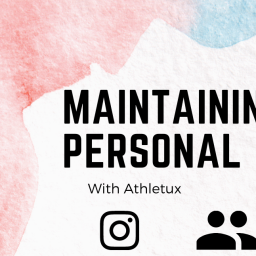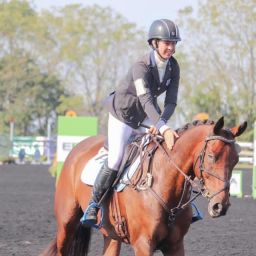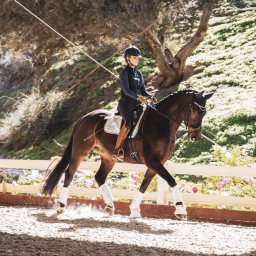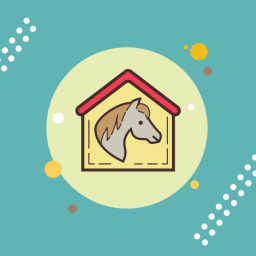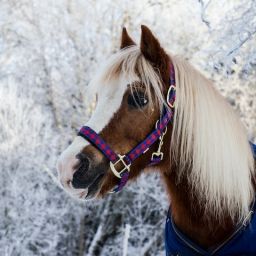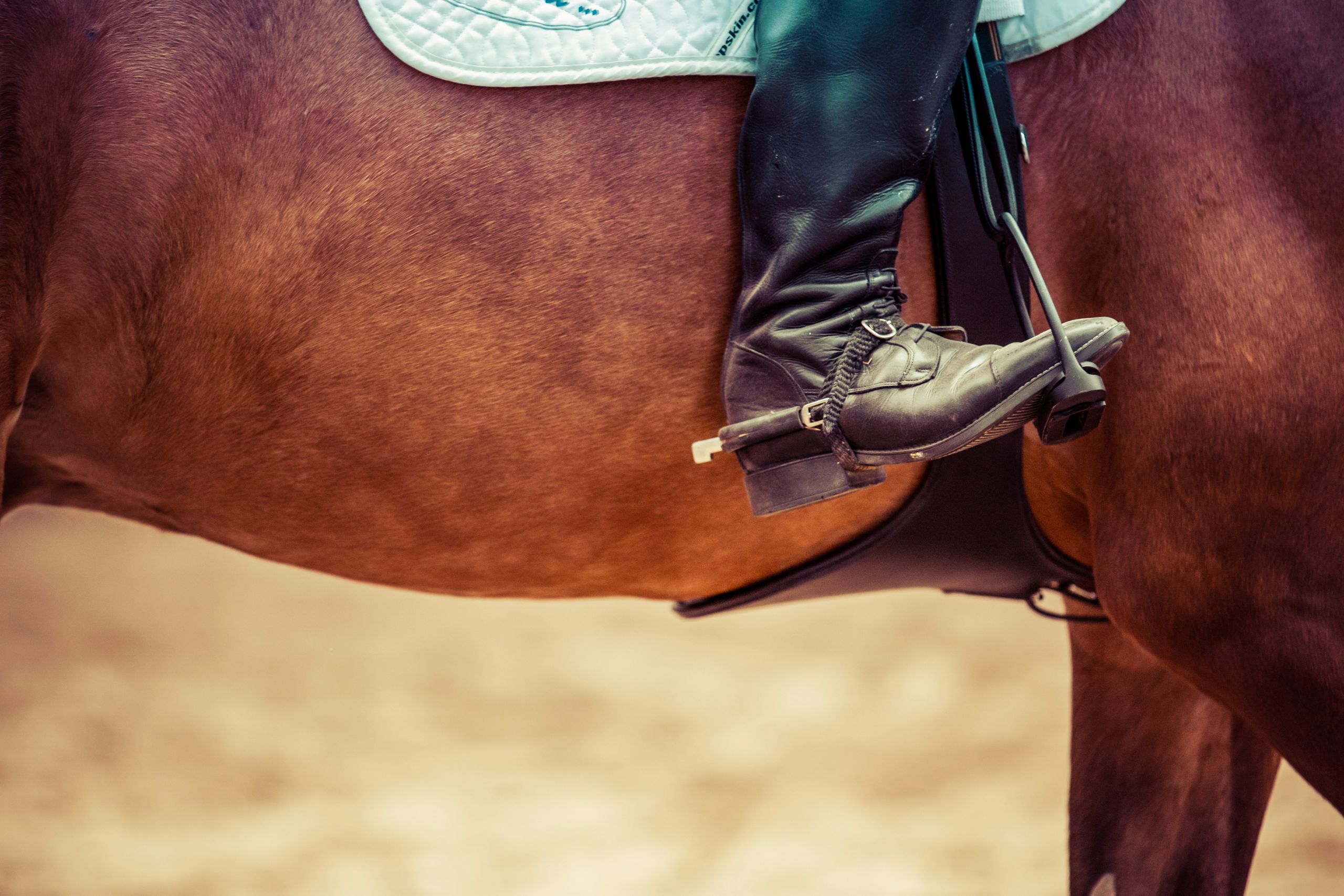
Less is More For Advancing Skills of Horse and Rider
We all strive to move up to the next skill level of riding. It keeps the ho-hum out of ring work for ourselves and our horses. A perfect transition precisely at E. A consistent on-the-money halt at X. Moving up to a flying change or extended trot and so on. It’s rewarding and exciting because the results are so visible.
There is however another level to move up to achieve. While it is a much less visible accomplishment, I guarantee what used to be the same old warm-up so we can do the exciting stuff, will become part of the exciting stuff. And, it doesn’t matter what kind of horse you have or what level of rider you are. All riders can achieve this no matter if you are a novice or if your horse is a backyard castoff from your older sister after she discovered boys.
It’s called riding with less. Need to use a ton of leg to get your horse going? Pull on the reins to get a down transition? Employ a fair amount of rein and leg pressure to get a round, bent to the outside circle?
What is exactly does riding with less mean? Simply put, it’s continuously lightening your aids to an ever-increasing level of invisibility. It’s a transition that looks like you are just sitting there doing absolutely nothing A roll-back using only your ringer and a tiny amount of weight shifted to your inside seat bone. It makes everything you do seem like your horse is a mind reader.
To ride with less means to vigilantly focus every moment of every day on your ride towards continuously lighten your aids and keep them that way. Now many of us have horses that may interpret less leg as a halfhearted attempt on our part to move forward. Or perhaps we have been taught to see it that way. How many times have we heard, “C’mon! You gotta let him/her know you mean it!”. Alas, riding with strong aids is like instead of saying to someone, “Excuse me, could you pass the peas”, you say “EXCUSE ME COULD YOU PLEASE PASS THE PEAS!”. Your horse isn’t deaf. Similarly, there’s the nudge-building. It goes something like this: nudge, (nothing) nudge, nudge, (nothing) nudge, nudge, nudge, (still nothing) until it’s KICK. And then if nothing happens then it’s KICK (nothing) KICK, KICK, (nothing) … you get the idea. By the way, here’s a word for that. It’s called nagging (or begging, whichever you prefer). Either way, it’s the same as “Could you please take out the trash?” “When are you going to take out the trash?” “Are you going to take out the trash or not?” “I’m not going to ask you one more time, take out the trash.” “TAKE OUT THE TRASH! NOW!!!” Your horse is not ignoring you either.
Your horse isn’t deaf or ignoring you. At least not on purpose. The truth is, someone taught your horse to be that way. He’s just doing things (or not doing things) the way he always has. To make things worse, the more a rider “yells” or “nags” only makes him/her become even less sensitive to the rider’s aids.
By continuing to ride our horses in the same fashion, we are reconfirming it’s the way things are done. Success will only come if, for the entire ride, you pay attention to how you are using your aids.
Begin while standing at the halt. Ask your horse to move forward into the walk by strongly and firmly closing your leg. If there’s no acknowledgment give a short, quick (once, and only once) strong tap of the whip behind your leg. Be prepared. Your horse might scoot forward out of surprise. You don’t want to accidentally pull on the reins because you weren’t ready for it. That will confuse your horse. Be sure to follow the movement of your horse’s head and neck when he steps forward into the walk. Keeping your hands still from when you were at the halt will hinder your horse from moving forward and limit a full potential.
I recommend using a dressage whip. Because it’s longer than a crop, you’ll be able to tap your horse right behind your ankle. The use of whip should not ever be heavy-handed. Most often just a tap will do. It depends on the sensitivity of your horse. You will need to judge that. Start with a tap and work up from there until you find the right intensity. Once your horse starts responding, work down to lighter taps until your horse moves off your leg without using the whip. Hang on, that doesn’t mean “mission accomplished”! Always ride with a whip. You’ll need to be ready to tap your horse forward immediately after a leg aid if you don’t get a timely response.
IMPORTANT NOTE: if you have a short fuse or a temper, do not do this exercise. Work on your tendencies first before wading into whip territory!
After your horse responds, praise immediately but don’t halt to praise. Keep walking or your horse will think you are praising him for stopping. The more enthusiastic the praise the better. Let your horse know how thrilled you are with her or him! Keep it positive so that your horse will always want to do something that’s not about avoiding punishment.
Allow 10 seconds to pass at the walk then transition back down to a halt. Always put about 10 seconds between each attempt. Do this for 10 – 15 minutes. Even if your horse isn’t progressing as quickly as you’d like, you tell if he or she is paying attention to you by watching your horse’s ears. If you see one ear flicking sideways or back after you apply your leg, it means your horse has listened to you. He or she might be just taking a moment or two to process this new information. However, both ears back is an entirely different thing. It means your horse has an opinion of what you are trying to do and it’s probably not a very agreeable one! Avoid getting irritated and certainly don’t punish him for it. He’s entitled to his emotions. Ignore it and just focus on moving forward. The lavish praise will help your horse make a positive shift.
Proceed to the trot and canter portion of your warm-up but continue to apply your leg for up transitions followed by the short, quick, one-time use of your whip just behind the ankle if you don’t get a response. It’s crucial for you to remember to ride this way through your entire ride. From now on, what began as an exercise must become a way of riding. Always.
This kind of work will require a little more physical effort from your horse. To move forward in a more immediate way means your horse will have to push off more with his hind legs. When you decide you both have the hang of it, increase the skill level by setting an expectation for a more immediate response from your leg. Stay aware that if you feel your horse trying but still a little “sluggish” it may be that she or he needs a little time to build a bit more strength. Continue to push him but be patient all the same. A good exercise to do for helping your horse build strength from behind is ground poles set to 3 – 4 inches high if possible. Do them at a medium trot while maintaining a steady rhythm with no rushing.
There’s often a question of spurs. Whether or not they are used is up to you. Some horses have thicker skin than others making it more difficult for them to feel what your leg is telling them. In that case, it would not be fair to apply the whip behind your leg for something they can’t feel in the first place. So, in this case, yes, spurs would be a good choice. But only if you can ride without gripping with your heels. Then you will only be deadening your horse’s sensitivity to your leg be back to square one. If you are trying spurs for the first time, you will be able to tell gripping if after going into the trot or canter your horse begins and continues to increase speed. Check to make sure your heels remain down and away from your horse’s body unless you are intentionally using them. You should do this regardless of spurs or not. Riders with sensitive skinned horses often use spurs, but only when they are entering into the stage of nuance. In this case, just a slight change of spur use is perceived and understood communication towards a specific response.
This same approach is used for down transitions and turns. Constantly work toward making the use of your reins lighter and lighter to the point where you only need the slightest squeeze of a ring finger to have an effect. It will be a big help if you follow the head and neck at the walk and canter by keeping your elbows flexible. Then you can use the hand or ring finger in the rhythm, which will also help your horse to keep moving forward. Also, use of your weight and hips to lighten the use of reins and leg. When going into a turn, make a perceptible shift of weight on your seat bone to right or left to the inside of your turn. Once you feel your horse picking up on seat bone use, start to lighten that too using less and less of a weight shift. Looking around your turn is also a good way to communicate more quietly with your horse. For down transitions or to shorten the stride, sink down your weight down into the saddle and shorten the back and forth hip movement. To lengthen the stride, widen your hip movements. When you are attempting to move up to doing a flying change, of course, there will be a heavier use of your aids. But once you get it down, start working towards lighter and less there too.
Every time you ride, keep working towards lighter and lighter, less and less. Do it from the moment you get on your horse to the moment you dismount. Every day. Always. No matter what.
Finally, think of whatever it is you are asking your horse to do before you ask. Whether it’s an up/down transition or the direction of a turn, I’ve tried it and continued to be amazed at the effect. I don’t care what anyone says – horses can read our minds. Although some are better at it than others. Those are the horses that know when the vet is coming for spring shots, so good luck catching that horse if he or she is out in the pasture!
So, ride with less, and you, my fellow rider friend, will become an elegant rider who rides with an indescribable finesse.
Now, that is something worth reaching for isn’t it?



